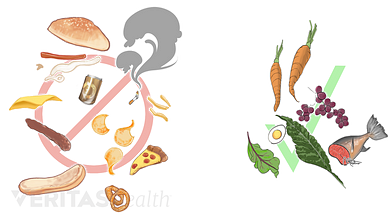
Summer months are a great time to eat healthy, cooling foods. Hotter seasons can make the digestive system more delicate, so it is crucial to reduce the intake of high-temperature foods. You should choose healthy ingredients for your meals and snacks. Be sure to consider the ingredients and the season, as well as your individual requirements. These are some of the best foods to eat during the summer. Here are some great choices for a nutritious diet.
Fruits and vegetables. Salads and fruits are more popular in summer. These foods are high in calories and sugar, which is why they aren't healthy. You should eat a variety of different fruits and vegetables during the summer, such as mangoes and guavas. These make great breakfast smoothies and pair well with fresh fruit. These healthy choices can be a great addition to your daily meal plan.
Melons. Muskmelons are great for boosting your energy. For those who feel tired in hot weather, this is especially helpful. They are full of vitamins and mineral, which will keep the body healthy and active all day. You can even feed your baby with muskmelons, which are easy to digest and are good for their gut. If you are worried about the sugar content of these foods, you could always mash them and make a drink out of it.

Apples. They are rich in water and great for summer. These fruits are loaded with pectin that helps maintain a smooth digestive system. The antioxidants in these delicious fruits will help you stay healthy. It also gives you a lot of energy. They are high in Vitamin A, and C which makes them great for dehydration-related diseases. Make sure you include healthy summer foods in your diet.
Tomatoes go well with any meal. Because they can be found in almost any season, tomatoes make a great option for lunch or dinner. They're also packed with vitamins and antioxidants that protect your body against the sun's harmful rays. You can enjoy delicious food without worrying about its harmful effects. They're good for your health, as well.
Berries make a great choice for summer. They are rich in fiber which is vital for healthy digestion. A cup of berries will improve your skin texture. It also contains antioxidants, which help your body fight serious diseases. Some berries offer more health benefits than others. If you are allergic or sensitive to any type of food, it is best to wait until you get older to eat them. Berries can help you maintain a healthy weight, in addition to being rich in vitamins and minerals.
Another great option for babies is yogurt. Yogurt is rich in protein, calcium, vitamin D, all of which are essential for a healthy digestive tract. Yogurt is also good for baby's teeth development as it contains protein. It is easily digestible and can be introduced to your baby as early as six months old. Make your own yogurt curd if your baby isn't familiar with yogurt. Try a simple homemade yogurt recipe if you aren’t sure what kind of yogurt to give your baby.

Watermelon, aside from fruits, is one of the most delicious summer foods. It is a natural source of lycopene, which is essential for heart health. It is also good for your overall health. To maximize the benefits, grill the melon and drizzle olive oil on it. You can also roast or grill watermelon for a delicious and savory snack. This fruit doesn't require any additional sugar, and it is a great snack choice in summer.
Summer is the best time to eat watery and rich in nutrients. Green beans are an excellent snack choice. These beans are 95% water, and can be given as finger food to children. Boiling cucumbers is a great snack option if you are unable to find healthy snacks. As long as you don't overdo it, you can enjoy a delicious meal while staying hydrated in the hotter months.
FAQ
What is the difference between a virus and a bacterium?
A virus is a microscopic organism which cannot reproduce outside of its host cell. A bacterium (or single-celled organism) reproduces by splitting itself into two. Viruses are very small (about 20 nanometers) while bacteria are larger (up to 1 micron).
Viruses are often spread through contact of infected bodily fluids like saliva, urine or semen. Bacteria is usually spread directly from surfaces or objects contaminated with bacteria.
Viruses may enter the body through cuts, scrapes. bites, or any other break in the skin. They can also be transmitted through the eyes, nose, mouth, ears, rectum, and anus.
Bacteria can get into our bodies through cuts, scrapes and burns, insect bites, or other skin breaks. They may also be introduced into our bodies through food and water as well as soil, dirt, dust, and animals.
Both bacteria as well as viruses can cause illness. Viruses can not multiply within the host. They infect only living cells, causing illness.
Bacteria can cause illness by multiplying in the body. They can infiltrate other parts of the body. They can even invade other parts of the body, which is why antibiotics are necessary to eradicate them.
What are 7 tips for a healthy and happy life?
-
Take care of your health
-
Exercise regularly
-
Rest well
-
Drink lots of water
-
Get enough rest
-
Be happy
-
Smile often
What is the difference in calorie and kilocalories?
Calories can be used to measure how much energy is in food. Calories are a unit of measurement. One calorie is equal to one degree Celsius in energy.
Kilocalories can also be used to refer to calories. Kilocalories measure in thousandths a calorie. 1000 calories, for example, equals one kilocalorie.
How often should I exercise?
Exercise is essential for maintaining a healthy lifestyle. However, there isn't a set amount of time you must spend working out. Finding something you enjoy is key. Stick with it.
Three times a week, you should be aiming to complete 20-30 mins of moderate intensity activity. Moderate intensity means that your muscles will continue to work hard even after you finish. This type of workout burns around 300 calories.
You can walk for 10 minutes every day if that is what you prefer. Walking is easy on the joints and has low impact.
Jogging three times a week for 15 mins is enough if you want to run. Running is a great way to burn off excess calories and build muscle tone.
You can start slow if you're new to exercise. Begin by only doing 5 minutes of cardio five times per week. Gradually increase the time you do cardio until your goal is reached.
Exercise: Good or Bad for Immunity?
Exercise is good for your immune system. Exercise increases white blood cell production, which helps fight off infection. Your body also gets rid of toxins. Exercise helps prevent diseases like cancer and heart disease. It also reduces stress levels.
But, too much exercise can lead to a weakening of your immune system. Exercising too hard can make your muscles sore. This causes inflammation, swelling, and can even lead to death. Your body then has to produce more antibodies to fight off infection. This can lead to allergic reactions and other autoimmune disorders.
So, don't overdo it!
How much should I weight for my height and age? BMI chart & calculator
A body mass index calculator (BMI) is the best way to find out how much weight you should lose. A healthy BMI range should be between 18.5 and 24,000. Aim to lose 10 pounds per month if your goal is to lose weight. Enter your weight and height into the BMI calculator.
Check out this BMI chart to determine if you are overweight or obese.
How can I live a life that is full of joy every day?
To live a happy life, the first step is to discover what makes you happy. Once you are clear about what makes you happy and satisfied, you can move on to the next step. You can also ask other people what they do to live the best lives possible every day.
You can also check out books like "How to Live Your Best Life" from Dr. Wayne Dyer. He talks about how to find happiness and fulfillment at all stages of our lives.
Statistics
- In both adults and children, the intake of free sugars should be reduced to less than 10% of total energy intake. (who.int)
- This article received 11 testimonials and 86% of readers who voted found it helpful, earning it our reader-approved status. (wikihow.com)
- WHO recommends reducing saturated fats to less than 10% of total energy intake; reducing trans-fats to less than 1% of total energy intake; and replacing both saturated fats and trans-fats to unsaturated fats. (who.int)
- nutrients.[17]X Research sourceWhole grains to try include: 100% whole wheat pasta and bread, brown rice, whole grain oats, farro, millet, quinoa, and barley. (wikihow.com)
External Links
How To
What does "vitamin" actually mean?
Vitamins are organic substances found naturally in food. Vitamins help us absorb nutrients from foods we eat. Vitamins cannot be produced by the body. They must be acquired from food.
There are two types vitamins: water soluble or fat soluble. Water-soluble vitamins dissolve easily when they are dissolved in water. Examples include vitamin C,B1 (thiamine), B2 (riboflavin), B3 (niacin), B6 (pyridoxine), folic acid, biotin, pantothenic acid, and choline. Fat-soluble vitamins can be stored in the liver or in fatty tissue. Vitamin D, E, K and A are some examples.
Vitamins can be classified according to biological activity. There are eight major types of vitamins:
-
A - Essential for healthy growth and health maintenance.
-
C - essential for nerve function and energy generation.
-
D - Vital for healthy bones and teeth
-
E - needed for good vision and reproduction.
-
K - Essential for healthy muscles and nerves.
-
P - vital for building strong bones andteeth.
-
Q - aids digestion and absorption of iron.
-
R – Required for the formation of red blood vessels.
The recommended daily intake (RDA), of vitamins varies with age, gender and physical condition. The U.S. Food and Drug Administration sets RDA values.
For example, the RDA for vitamin A is 400 micrograms per dayfor adults 19 years or older. Because it is essential for the development of the fetus, pregnant women should consume 600 micrograms per daily. Children ages 1-8 require 900 micrograms per day. Infants below one year old require 700mg per day. But, between 9 months to 12 months, the amount drops to 500mg per day.
Children between the ages of 1-18 need 800 micrograms per daily for obesity, while children overweight require 1000 micrograms. Children underweight or obese will need 1200 mg per day.
2200 mg of vitamin A per day is required for children aged 4-8 who have been diagnosed by anemia.
2000 micrograms per person is necessary for general health. Due to their increased nutrient needs, pregnant and breastfeeding women need 3000 micrograms daily.
Adults over 70 need 1500 micrograms daily, as they lose 10% of their muscle every ten years.
Women who are pregnant, nursing or breastfeeding need more than the RDA. Pregnant woman need 4000 micrograms daily in pregnancy, and 2500 per day after childbirth. Breastfeeding mothers need 5000 mg per day when breastmilk is being produced.